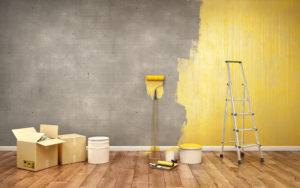
Metallic paint is a faux finish that, when painted on walls, doors or ceilings, brings an added sparkle to your home. It takes a little more elbow grease to apply than a standard paint job, and you need to know some special techniques to get the best look. We’ll walk you through the tips and tricks you need to make this finish shine.
Common Issues With Metallic Paint
Metallic paint comes in a range of colors like gold, silver, copper, bronze and even unexpected hues like teal and pink. (Check out PPG’s Metallic Paints for more color ideas.)
Because this is a high-sheen finish, there are some watch-outs you need to know. Any time you change sheens, whether you’re painting on walls, ceilings or doors, all of the imperfections in the paint will show. (This applies to high-gloss paint, too.)
Metallic paint is flecked with mica, which also exposes brush strokes. So, in addition to carefully preparing the surface, you also need to use certain tools and paint techniques to avoids lines, stripes and blemishes.
Prepping and Painting Tips
Usually, when you paint, you cut in around corners, edges and ceilings with a brush and then do the actual painting with a large roller. But a brush leaves lines in metallic paint, which is different than the roller’s finish, which is more like a stipple. If you do the usual brush/roller technique, you can an obviously visible line around the walls.
How do you get around that? Start by taping off the room, making sure the tape really sticks to the wall, because you’re going to paint right against it.
Then use a small roller (about four inches) to cut in around the ceiling and edges. Use a roller that’s the same nap and material as the large one you use on the walls. For example, if you’re using a half-inch nap roller to cut in, use a half-inch nap roller on the walls.
If you can reach floor to ceiling without a ladder, you’ll get the best results by cutting in and painting at the same time. But if you’re working with a ladder, you can cut in first, let that coat dry, and then do the walls. Any difference will hardly be noticeable.
Before you break out the metallic paint, prep the walls carefully. Fill any imperfections with spackle, sand them and then clean the walls.
Once that’s done, prime the walls and then paint them in a color similar to the metallic paint you’re using. This is a lot of work, but it will make the difference between success and failure with a metallic paint. Taking these steps seals the walls and creates a smooth, consistent surface to paint over.
If you’re cutting in and painting at the same time, work in three-foot sections from top to bottom. The metallic pigments lay out in whatever direction you roll. So on your final coat, start at the top and roll lightly to the bottom. This will make sure the pigments all lay the same way, so that your finish glistens evenly.
Let the paint dry for four to six hours then do a second coat. Before the final coat, check for any imperfections, sand any you find with fine-grit paper and then wipe clean.
For your final step, remember to smooth lightly from top to bottom. As it starts to dry, the paint will probably look blotchy. Don’t touch it up, though, because that will leave a line. As the paint dries, it will smooth out.
Wondering how metallic paint would look in your home? Get a color consultation and we’ll send you free 8” x 8” paint swatches. Learn more about our interior paint services and let us transform your home today.